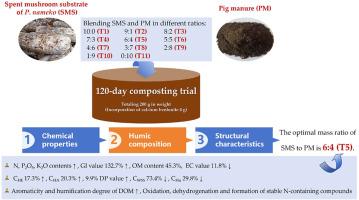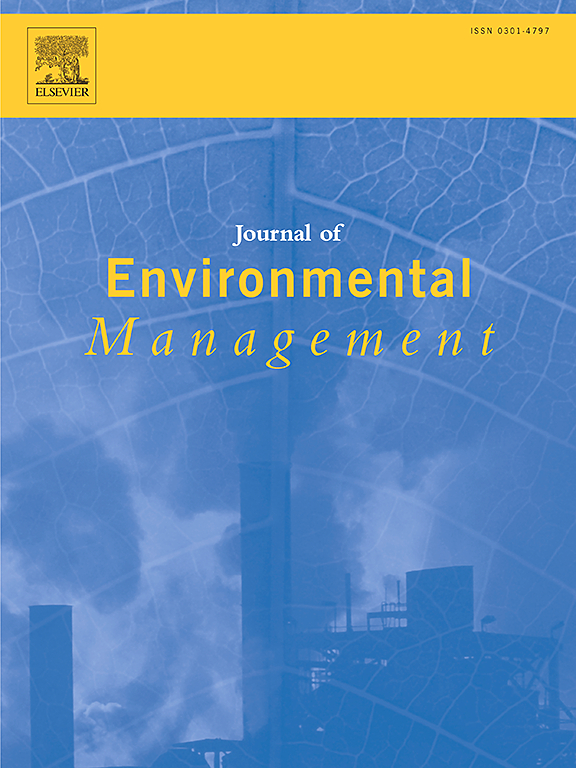Performance of co-composting Pholiota nameko spent mushroom substrate and pig manure at different proportions: Chemical properties and humification process
IF 8
2区 环境科学与生态学
Q1 ENVIRONMENTAL SCIENCES
引用次数: 0
Abstract
Co-composting is the controlled aerobic degradation of organics, using more than one feedstock. By combining the spent mushroom substrate of Pholiota nameko (SMS) and pig manure (PM), the benefits of each could be used to optimize the composting process and the final product. This study introduced a comprehensive evaluation strategy aimed at identifying the optimal co-composting ratio for these two substrates. A 120-day composting trial was conducted, blending SMS and PM in various ratios to evaluate the benefits of co-composting SMS-PM. The results indicated that dissolved organic matter (DOM) in SMS-derived compost primarily originated from plants, whereas PM-derived compost predominantly consisted of microbial metabolic products, and co-composting combined both sources. An increase in aromaticity and humification degree of DOM occurred during the composting process itself rather than being derived from autochthonous origin. Carbohydrates like phenols and alcohols broke down during composting, and microbes utilized polysaccharides as an energy source for humus formation. As co-composting progressed, the treatments with varying mass ratios of SMS to PM, including 8:2, 7:3, 6:4, 5:5, 4:6, and 3:7 were observed to result in a decline in aliphatic hydroxylated chains alongside an enhancement in aromaticity within the compost. Additionally, there was a conversion from organic carbon (C) to carboxyl C within humic acid (HA) due to oxidation and dehydrogenation processes that facilitated the formation of stable nitrogen-containing compounds characterized by condensed aromatic structures. Following thorough evaluation, it was determined that optimal composting efficacy occurred at a mass ratio of SMS to PM equal to 6:4. Post-compost analysis revealed increases in nutrient content; specifically, germination index (GI) value reached 132.7%, while organic matter content attained 45.3%. Conversely, electrical conductivity (EC), C contents of water-soluble substances and humin (Cwss and CHu) decreased by approximately 11.8%, 73.4%, and 29.8% respectively; meanwhile, C contents of humic-extracted acid and HA (CHE and CHA), along with degree of polymerization (DP), increased by 17.3%, 20.3% and 9.9% respectively. The proposed co-compost formula not only facilitated simultaneous recycling of both SMS and PM waste but also transformed them into high-quality organic fertilizers suitable for soil enrichment—effectively addressing challenges faced by both edible fungi cultivation and livestock industries while augmenting organic fertilizer sources for Black land protection.

不同比例的 Pholiota nameko 废蘑菇基质和猪粪共同堆肥的性能:化学特性和腐殖化过程
协同堆肥是利用一种以上的原料对有机物进行有控制的好氧降解。通过将废蘑菇基质 Pholiota nameko(SMS)和猪粪(PM)结合起来,可以利用每种基质的优点来优化堆肥过程和最终产品。本研究引入了一种综合评估策略,旨在确定这两种基质的最佳共堆肥比例。我们进行了一项为期 120 天的堆肥试验,将 SMS 和 PM 按不同比例混合,以评估 SMS-PM 堆肥的益处。结果表明,SMS 制成的堆肥中的溶解有机物(DOM)主要来自植物,而 PM 制成的堆肥主要由微生物代谢产物组成,而共堆肥结合了这两种来源。在堆肥过程中,DOM 的芳香度和腐殖化程度都有所提高,而不是来自自生来源。酚类和醇类等碳水化合物在堆肥过程中分解,微生物利用多糖作为腐殖质形成的能量来源。随着共堆肥的进行,观察到 SMS 与 PM 的不同质量比处理(包括 8:2、7:3、6:4、5:5、4:6 和 3:7)导致脂肪族羟基链减少,同时堆肥中的芳香度增加。此外,由于氧化和脱氢过程,腐殖酸(HA)中的有机碳(C)转化为羧基碳(C),从而形成了稳定的含氮化合物,其特点是具有缩合芳香结构。经过全面评估,确定 SMS 与 PM 的质量比为 6:4 时堆肥效果最佳。堆肥后的分析表明,营养成分含量有所增加;具体来说,发芽指数(GI)值达到 132.7%,有机物质含量达到 45.3%。相反,电导率(EC)、水溶性物质和腐殖质的 C 含量(Cwss 和 CHu)分别下降了约 11.8%、73.4% 和 29.8%;而腐殖酸和 HA 的 C 含量(CHE 和 CHA)以及聚合度(DP)则分别增加了 17.3%、20.3% 和 9.9%。所提出的共堆肥配方不仅促进了 SMS 和 PM 废弃物的同时循环利用,还将其转化为适用于土壤增肥的优质有机肥料,有效地解决了食用菌种植和畜牧业所面临的挑战,同时增加了黑土地保护的有机肥源。
本文章由计算机程序翻译,如有差异,请以英文原文为准。
求助全文
约1分钟内获得全文
求助全文
来源期刊

Journal of Environmental Management
环境科学-环境科学
CiteScore
13.70
自引率
5.70%
发文量
2477
审稿时长
84 days
期刊介绍:
The Journal of Environmental Management is a journal for the publication of peer reviewed, original research for all aspects of management and the managed use of the environment, both natural and man-made.Critical review articles are also welcome; submission of these is strongly encouraged.
 求助内容:
求助内容: 应助结果提醒方式:
应助结果提醒方式:


